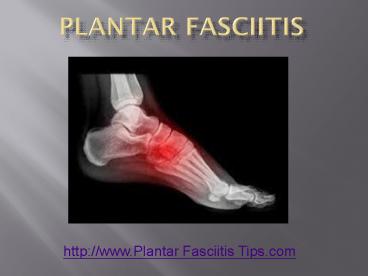Plantar Fasciitis - PowerPoint PPT Presentation
Title:
Plantar Fasciitis
Description:
Plantar fasciitis (PLAN-tur fas-e-I-tis) is one of the most common causes of heel pain. It involves pain and inflammation of a thick band of tissue, called the plantar fascia, that runs across the bottom of your foot and connects your heel bone to your toes. – PowerPoint PPT presentation
Number of Views:451
Title: Plantar Fasciitis
1
Plantar fasciitis
- http//www.Plantar Fasciitis Tips.com
2
Table of content
- Chapter 1 What is Plantar Fasciitis
- Chapter 2 What causes Plantar Fasciitis
- Causes
- Risk Factors
- Complications
- Chapter 3 How to treat Plantar Fasciitis
- Medications
- Therapies
- Surgical or other procedures
3
Chapter 1 What is Plantar Fasciitis
- Plantar fasciitis (PLAN-tur fas-e-I-tis) is one
of the most common causes of heel pain. It
involves pain and inflammation of a thick band of
tissue, called the plantar fascia, that runs
across the bottom of your foot and connects your
heel bone to your toes. - Plantar fasciitis commonly causes stabbing pain
that usually occurs with your very first steps in
the morning. Once your foot limbers up, the pain
of plantar fasciitis normally decreases, but it
may return after long periods of standing or
after getting up from a seated position. - Plantar fasciitis is particularly common in
runners. In addition, people who are overweight
and those who wear shoes with inadequate support
are at risk of plantar fasciitis.
4
Chapter 2 What causes Plantar Fasciitis
- Causes
- Under normal circumstances, your plantar fascia
acts like a shock-absorbing bowstring, supporting
the arch in your foot. If tension on that
bowstring becomes too great, it can create small
tears in the fascia. Repetitive stretching and
tearing can cause the fascia to become irritated
or inflamed. - Risk Factors
- Factors that may increase your risk of developing
plantar fasciitis include - Age. Plantar fasciitis is most common between the
ages of 40 and 60. - Certain types of exercise.
- Activities that place a lot of stress on your
heel and attached tissue, such as long-distance
running, ballet dancing and dance aerobics, can
contribute to an earlier onset of plantar
fasciitis.
5
- Faulty foot mechanics.
- Being flat-footed, having a high arch or even
having an abnormal pattern of walking can
adversely affect the way weight is distributed
when you're standing and put added stress on the
plantar fascia. - Obesity.
- Excess pounds put extra stress on your plantar
fascia. - Occupations that keep you on your feet.
- Factory workers, teachers and others who spend
most of their work hours walking or standing on
hard surfaces can damage their plantar fascia. - Complications
- Ignoring plantar fasciitis may result in chronic
heel pain that hinders your regular activities.
If you change the way you walk to minimize
plantar fasciitis pain, you might also develop
foot, knee, hip or back problems.
6
Chapter 3 How to treat Plantar Fasciitis
- Most people who have plantar fasciitis recover
with conservative treatments in just a few
months. - Medications
- Pain relievers such as ibuprofen (Advil, Motrin
IB, others) and naproxen (Aleve) may ease the
pain and inflammation associated with plantar
fasciitis. - Therapies
- Stretching and strengthening exercises or use of
specialized devices may provide symptom relief.
These include
7
- Physical therapy.
- A physical therapist can instruct you in a series
of exercises to stretch the plantar fascia and
Achilles tendon and to strengthen lower leg
muscles, which stabilize your ankle and heel. A
therapist may also teach you to apply athletic
taping to support the bottom of your foot. - Night splints.
- Your physical therapist or doctor may recommend
wearing a splint that stretches your calf and the
arch of your foot while you sleep. This holds the
plantar fascia and Achilles tendon in a
lengthened position overnight and facilitates
stretching. - Orthotics.
- Your doctor may prescribe off-the-shelf heel
cups, cushions or custom-fitted arch supports
(orthotics) to help distribute pressure to your
feet more evenly.
8
- Surgical or other procedures
- When more-conservative measures aren't working,
your doctor might recommend - Steroid shots. Injecting a type of steroid
medication into the tender area can provide
temporary pain relief. Multiple injections aren't
recommended because they can weaken your plantar
fascia and possibly cause it to rupture, as well
as shrink the fat pad covering your heel bone. - Extracorporeal shock wave therapy. In this
procedure, sound waves are directed at the area
of heel pain to stimulate healing. It's usually
used for chronic plantar fasciitis that hasn't
responded to more-conservative treatments. This
procedure may cause bruises, swelling, pain,
numbness or tingling and has not been shown to be
consistently effective. - Surgery. Few people need surgery to detach the
plantar fascia from the heel bone. It's generally
an option only when the pain is severe and all
else fails. Side effects include a weakening of
the arch in your foot.
9
- If you are someone who likes to learn by doing,
then these must see plantar fasciitis pain
relieving video by clicking on the link below to
go to the site of Greg Hunter Founder of - PlantarFaciitisTips.com






























![[PDF] Plantar Fasciitis Survival Guide: The Ultimate Program to Beat Plantar Fasciitis! Kindle Edition Ipad PowerPoint PPT Presentation](https://s3.amazonaws.com/images.powershow.com/10086700.th0.jpg?_=20240727121)
